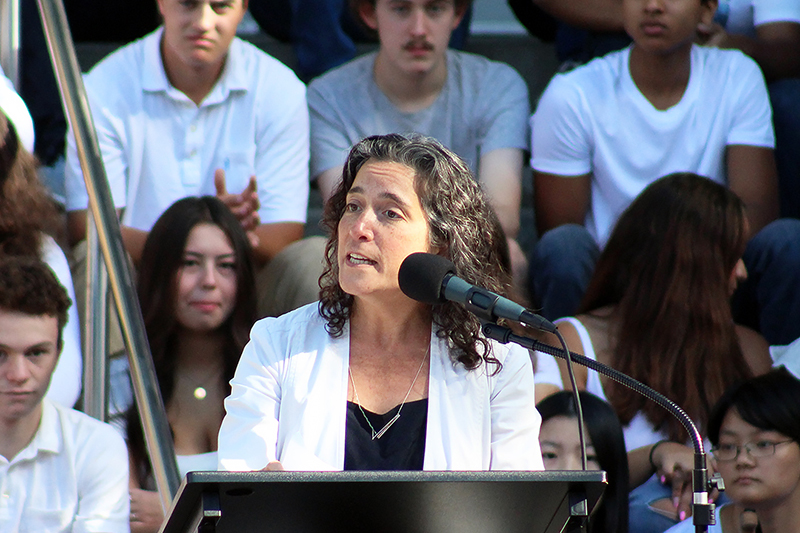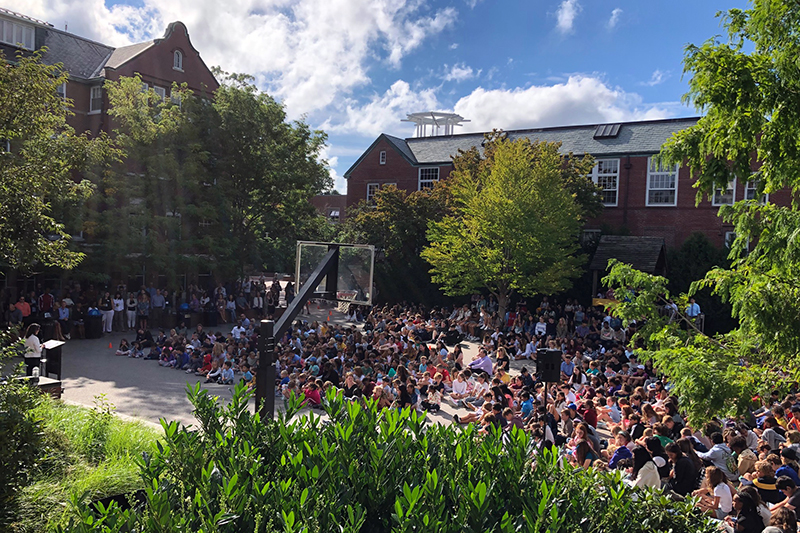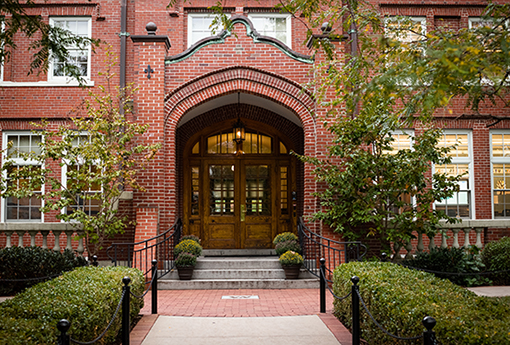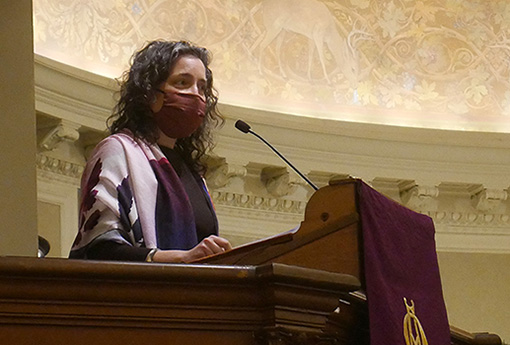
A Call to Be Curious
September 8, 2022

The following are Head of School Allison Gaines Pell P’23, P’25’s remarks at the Opening Assembly for the 2022-23 school year.
Good morning and welcome to the 134th school year at Wheeler! For our new students, I am Allison Gaines Pell, HOS at Wheeler. I use she/her pronouns. You can call me AGP or Ms. Pell! For our many returning students, welcome back. We are so happy to see you!
I’m pleased to welcome the class of 2023 to the steps to open this school year, along with some of our youngest learners. To those of you who are just beginning at Wheeler, know that one day, you too will be sitting here as you embark on your last year at Wheeler! To those who are our seniors, I’m sure you feel in some ways it was just yesterday that you were the age of those who sit by your sides. I know your families feel that way.
First, some gratitude.
Thank you to Miss Wheeler for the vision to bring the Wheeler Farm and the Wheeler School into existence.
Thank you to the many hands and minds over the generations who have shaped the wonderful school we have today.
Thank you to our parents and guardians who aren’t here today but who are with us in spirit, wishing us all a great year together.
Thank you to all of our administrative teams, from summer camp, maintenance, enrollment, business, operations, technology, communications, and advancement, who worked here over the summer to prepare for this very moment and who keep the trains running and keep us improving all the time.
Thank you to our entire staff and faculty. Every one of you has been working hard to get ready for these really fine young people gathered here today.
Thank you to our students, who inspire us to be our best selves, who make us laugh and make us proud.

A long time ago, longer for those of us adults around here and our upper schoolers, but more recently for those of you in our lower school, we all started with some very big questions. When we are babies, we ask questions by trying to discover the world. Babies look at their hands and wonder what they are. They put everything in their mouths! They ponder how they can use their arms and legs to start moving from one place to another. Later on, they understand that they can use their mouths and hands to communicate. In the first three years of life, our human brains make billions of neural connections (almost 1 million per second!), all through the act of questioning and figuring out the world. As we grow, we experience all kinds of things that pique our curiosity, and if we do it right, as we grow older, new questions keep arising and our lives remain joyful because there is always more to find out and try out.
This summer, we witnessed the first images from the James Webb Space Telescope. The images showed us parts of the universe never seen before by the human eye stretching back 13 billion years, almost to the big bang (if you haven’t seen the images, search for them today!). According to scientists, what they show only just scratches the surface of what is possible to learn from this new telescope. And these images exist only because scientists asked those simple questions: what can we find out about the beginning of the universe? And what can the many stars and galaxies around us help us learn about the secrets to life on earth?
The path to get there was not easy! The journey started in the 1980s, even as finishing touches were being put on NASA’s Hubble Telescope which in itself represented a huge step forward in space observation. Scientists knew that an even more powerful telescope would be needed to answer these even deeper questions that we have as a species trying to learn about the universe.
The telescope was funded in the early 1990s, with the idea that it would take about ten years and cost NASA $1 billion dollars. But this pursuit in fact required several decades of planning and implementation. It took thousands of people, and many, many setbacks. It required new levels of ingenuity, creativity, and resilience to continue to persist as the project quadrupled in size and doubled in timeline.
Why was it so difficult? Well, to meet the goals of its mission, Webb would need a 21-foot mirror (almost thrice the size of the Hubble’s mirror). It would need a tennis court-sized sun shield to keep heat away, and it would require both of those things to be folded up inside the rocket while it launched, and then to unfold perfectly into a precise position once it was safely 1 million miles away from Earth’s atmosphere (and its heat). The launch, from the launchpad at the equator on December 25th 2021, would have to be perfect, and then, as it made its 1 million-mile climb into space, it would need to complete 344 “single-point failures,” meaning that each of those 344 elements needed to go just right in order and to work perfectly well for Webb to succeed. In the end, this feat of engineering – and of human curiosity and capacity – mirrored nature itself, as many described the telescope wrapped up in its own mirrors and heat shields like a butterfly’s chrysalis that would unwrap day after day.
All that trouble was worth it. For now we can see what Webb can see! We can now wonder aloud whether there might be life in some of these galaxies, or what enabled life to exist here. As New York Times reporter, Dennis Overbye wrote just before the launch, “There are only a few times in the history of a species when it gains the know-how, the audacity and the tools to greatly advance the interrogation of its origins. Humanity is at such a moment.”
The day these images came out, it was said that scientists were in tears of joy at their desks. I like to imagine all of those scientists in their schools in this country and other countries many years ago when they were 5 or 8 or 16, looking up to the stars, reading about the big bang, making things in their bedrooms or garages with what was available, and thinking about how they might one day be part of a venture to advance our understanding of our universe and thus, ourselves, more than our species had ever imagined. And consider the thought that the very materials used to build the telescope were those that were formed by the big bang, the very event that the telescope is trying to capture!
In that spirit, I remind you that those young people are also you, so I send you off to this new year with a call for you to be curious. This year, I hope you will all follow your own questions whatever they may be about – our history, your classmates, your family, your community, your world. Your questions will be your own. Do you wonder about music, or travel, or geology, or about someone who has a different life than you, or about what lives underground, or about how trees talk to one another, or about the best way to make a meringue, or how much impact recycling can have on the environment, or anything else?
Treasure those questions like the precious gifts they are – they make you who you are, and they could result in something that changes our world one day. Our Unity and Diversity theme this year “knowing ourselves and each other,” comes in right on cue, and reminding us that our curiosity can lead us to new relationships, new ways of learning about each other, a more open mind, the ability to be flexible and nimble in our thinking. When you approach your new friends and old this year, just like the telescope, consider everyone you meet a lens into a world we could only previously imagine. I challenge each of us this year to find our own beautiful, powerful, driving questions, and to pursue them without end.
So, with this, I open the 134th school year at The Wheeler School, a year in which this group of 1,055 people including our friends on both campuses, together with the thousands of parents, guardians, community members and friends, will come together to learn, play, and wonder, and most critically, to live out our mission, to learn our powers and be answerable for their use.
Congratulations to our seniors who will, I know, be role models this year in their curiosity and so much else, and my best wishes for everyone to have a wonderful year.

